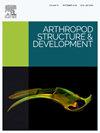The first complete larval development of the parasitic barnacle from the genus Briarosaccus
IF 1.3
3区 农林科学
Q2 ENTOMOLOGY
引用次数: 0
Abstract
The complete larval development of Briarosaccus hoegi (Rhizocephala: Peltogastridae), including five naupliar and one cypris stages, is described and illustrated using SEM. The present study confirms that all rhizocephalans have 5 naupliar stages during the larval development. The larvae of B. hoegi are almost twice as large as the larvae of other rhizocephalans. Male larvae are considerably larger than female ones, their sizes never overlap. Larvae of B. hoegi show the peltogastrid type of development. Late male nauplii have large frontal protrusions, absent in female larvae. The second antennular segment in male nauplii is definitely longer than that in female larvae. These two characters indicate a distinct sexual dimorphism between male and female nauplii of rhizocephalans. Nauplii and cyprid of B. hoegi have pigmented nauplius eyes and show positive phototaxis. There is no correlation between the presence of a flotation collar and a nauplius eye in rhizocephalan larvae. The attachment disc in the female cyprid has a flap-like extension at the posterior margin. The attachment disc in male and female cyprids possesses two sensory setae. The large aesthetasc in the male cyprid is unilobed. The subterminal aesthetasc in female cyprid terminates into a single long filamentous process. A short postaxial sensory seta on the second antennular segment is completely reduced in the male cyprid. The nauplii and cyprids of B. hoegi and Briarosaccus tenellus are very similar. Our study confirms that the genus Briarosaccus consists of two cryptic species.
寄生藤壶属的第一个完整的幼虫发育
本文用扫描电镜(SEM)描述和说明了北野蔷薇(Briarosaccus hoegi)的完整幼虫发育过程,包括5个幼体期和1个幼体期。本研究证实,所有的根头类动物在幼虫发育过程中都有5个无足期。白弧菌的幼虫几乎是其他根头虫幼虫的两倍大。雄幼虫比雌幼虫大得多,它们的大小从不重叠。虎纹夜蛾幼虫发育呈胃腹型。晚期雄性nauplii有大的额突,在雌性幼虫中没有。第二触角节在雄性nauplii幼虫明显长于雌性幼虫。这两个特征表明根头类动物雌雄生殖道具有明显的两性二态性。绿僵菌的绿僵菌和绿僵菌有色素化的眼,呈正向趋光性。在根头蝇幼虫中,浮领的存在与无钩眼之间没有相关性。女性塞浦路斯的附着盘在后缘有瓣状延伸。雄性和雌性塞的附着盘具有两个感觉刚毛。大的美学在男性的塞浦路斯是不开放的。雌性丝状体的次端美学终止于一个长丝状突起。短轴后感觉设在第二触角节完全减少在男性塞浦路斯。白僵菌和细刺棘菌的nauplii和cyplii非常相似。我们的研究证实了Briarosaccus属由两个隐种组成。
本文章由计算机程序翻译,如有差异,请以英文原文为准。
求助全文
约1分钟内获得全文
求助全文
来源期刊
CiteScore
3.50
自引率
10.00%
发文量
54
审稿时长
60 days
期刊介绍:
Arthropod Structure & Development is a Journal of Arthropod Structural Biology, Development, and Functional Morphology; it considers manuscripts that deal with micro- and neuroanatomy, development, biomechanics, organogenesis in particular under comparative and evolutionary aspects but not merely taxonomic papers. The aim of the journal is to publish papers in the areas of functional and comparative anatomy and development, with an emphasis on the role of cellular organization in organ function. The journal will also publish papers on organogenisis, embryonic and postembryonic development, and organ or tissue regeneration and repair. Manuscripts dealing with comparative and evolutionary aspects of microanatomy and development are encouraged.

 求助内容:
求助内容: 应助结果提醒方式:
应助结果提醒方式:


